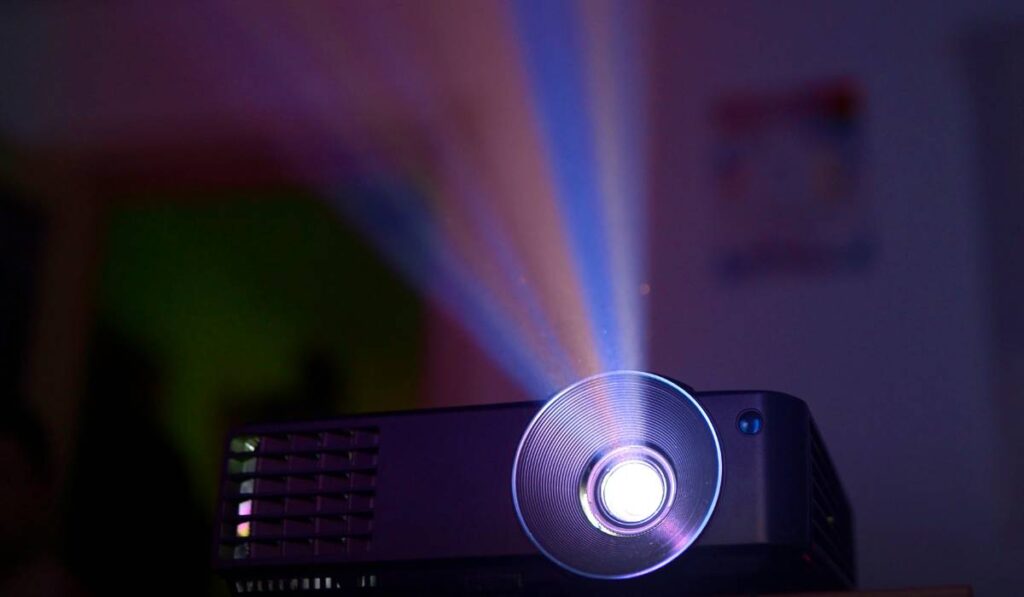With the rising popularity of laser projectors for home theaters and presentations, many wonder if laser projectors damage the eyes. Unlike traditional projector light bulbs, laser projectors use concentrated laser beams to project light which enables brighter, clearer images. However, intense laser light also brings risks of retinal damage if exposed to the eyes.
In this blog, we’ll explore the different classes of lasers used in projectors, discuss the potential dangers of direct eye exposure, and provide safety tips for properly operating laser projectors so you can enjoy their movie-theater image quality without worrying about damage to your vision.
Can Laser Projectors Damage Your Eyes?
Yes, laser projectors can potentially damage your eyes if not used properly. Here are a few key points about laser projector safety:
- Laser light is much more concentrated than regular light, so looking directly into the laser beam can harm the retina. Even low-power lasers used in projectors need to be treated carefully.
- Class 1 and Class 2 lasers used in most consumer projectors are considered eye-safe during normal operation if the user follows instructions. But still don’t stare directly into the beam.
- Class 3R and Class 4 lasers used in some higher-end projectors can potentially cause temporary or permanent eye damage with even brief exposure. Special engineering controls are required for safe operation.
- Never look through optical devices like telescopes or microscopes when pointing them at a laser projector, as this can greatly increase the risk of retinal injury.
- Keep kids and pets away from laser projector beams. Don’t point them at planes or vehicles where the driver could be distracted.
- Long-term eye exposure to even low-level laser light is still being studied. It’s best to take occasional breaks when using laser projectors.
Laser projectors are safe if operated properly, but direct eye exposure should always be avoided as a precaution. Proper safety instructions from the manufacturer should always be followed.
What Are the Symptoms of Eye Damage From a Laser Projector?

Looking directly into the powerful beam of a laser projector can cause damage to the eyes, particularly the sensitive retina, leading to permanent vision problems. The severity of the damage depends on factors like beam intensity and duration of exposure.
Milder cases may result in blurred or distorted vision, seeing spots or flashing lights, headaches, and excessive tearing or light sensitivity. More significant exposure can cause a partial or complete loss of vision in the affected eye. There may be a dark or empty spot in the field of vision corresponding to the damaged area of the retina. Central vision is especially critical for activities like reading and driving. In extreme cases, direct laser exposure can cause permanent blindness if the macula (central retina) is damaged.
Delayed symptoms like vision loss may take hours or days to manifest after the initial eye exposure to a laser beam. Any symptoms following suspected laser eye damage should be evaluated promptly by an eye doctor to assess the injury and recommend treatment options.
Are Certain Types of Laser Projectors More Likely to Cause Eye Damage?
Laser projectors use different laser sources and power levels that can impact safety risks. Small portable projectors often use less powerful diodes or DPSS lasers that may cause minor temporary vision impairment but are less likely to cause permanent eye injury with brief exposures.
More powerful laser projectors used in large venues or outdoor displays can project over large areas and often use more intense gas or solid-state lasers. Their beams can damage the eye from longer viewing distances.
Powerful wide-spectrum “full color” laser projectors mix red, green, and blue lasers, multiplying eye hazards. Infrared and ultraviolet laser projectors are also extremely dangerous, as their beams are invisible yet highly focused, making accidental exposure more likely.
Unauthorized modifications and defective safety features can also increase risks. While any laser projector requires care, high-power systems with complex multi-wavelength beams present more potential for severe eye damage with direct exposure and demand maximum caution.
Safety Precautions for Your Eyes When You Are Looking at Projectors
Here are some key safety precautions you should take when looking at projectors to protect your eyes:
- Avoid looking directly into the projection beam. Even low-power laser projectors can cause harm if you stare into the beam.
- Do not attempt to disassemble or repair the projector yourself. This could expose you to intense light levels. Leave repairs to qualified technicians.
- Follow positioning guidelines. Most projectors should be at least 5 feet above eye level and several feet away from the viewer for safe operation.
- Use the provided lens cover or shutters when changing the lamp or optics. This prevents accidental exposure during service.
- Only use replacement lamps specified by the manufacturer. Using lamps with incorrect power levels could compromise safety features.
- Keep children and pets away when the projector is in use. They may not understand the risk of the projection beam.
- Take periodic breaks when doing prolonged viewing. Give your eyes a chance to rest from the bright projected light.
- Consider using safety glasses with adequate optical density filters if recommended for the projector class you are using.
- Have your eyes checked regularly by an optometrist. They can monitor for any effects from long-term light exposure.
Being aware of potential risks and following basic precautions can help protect your vision when enjoying all the fun and educational uses of home and office projectors. Your eyes are precious, so prioritize safety.
Frequently Asked Questions
Can Direct Exposure to Laser Projector Light Harm My Eyes?
Laser projectors use powerful, concentrated beams of light to project images. While the light emitted from a laser projector is considered safe when viewed indirectly on a projection screen or surface, direct eye exposure can potentially cause damage. Looking directly into a laser projector beam can expose the eyes to high levels of radiant energy.
This intense light can heat and physically damage the retina, leading to permanent vision impairment or even blindness if the exposure is significant. The retina is especially vulnerable to laser damage because it lacks the ability to regenerate itself.
For this reason, it is critical to avoid staring into the beam of a laser projector or pointing it directly at someone. Brief, accidental exposure is unlikely to cause harm, but prolonged, deliberate eye exposure poses a real risk. Using laser projectors responsibly by following safety precautions can reduce the chances of eye injury.
Are Children More Susceptible to Eye Damage From Laser Projectors?
Yes, children’s developing eyes are generally more vulnerable to injury from laser projectors. A child’s pupils tend to be larger, allowing more laser light to enter the eye and be focused on the retina. Their lenses are also clearer, making them less effective at absorbing some wavelengths of laser energy.
Children may stare for longer durations out of curiosity since they are less aware of the risks. Their smaller stature also means their eyes are closer to the typical position of a laser projector. Furthermore, a child’s retina is not fully developed, making it more sensitive to damage that disrupts normal maturation.
Laser exposure at a young age could cause vision impairment that affects them for life. Younger children under 10 are especially susceptible. Ensure laser projectors are positioned high and out of reach and supervise children closely around these devices. Discourage looking directly into laser beams and teach children to avert their eyes. Take extra precautions to prevent laser accidents and eye injuries for children.
How Are Laser Projectors Regulated to Ensure Eye Safety?
The potential for laser projectors to cause eye injuries has led to safety regulations governing their design and use. In the U.S., laser products like projectors must meet hazard class limits and other requirements of the FDA/CDRH and follow ANSI Z136 standards.
Mandatory controls include enclosed projections, scanned beams, emission delays, and automatic power-down features if the beam path is obstructed. Warning labels must indicate laser radiation risks. Operators are expected to restrict beam paths and viewer exposure. The FDA regulates sales and manufacturers must report incidents involving eye injuries. Imports not meeting standards can be denied entry.
Professionals who use laser projectors face additional controls under OSHA regulations. Compliance helps restrict accessible beams to safer Class 1 or Class 2 designations. While regulations aim to improve safety, diligent use of approved laser projectors and avoiding direct eye exposure remains vital.
In Summary
While laser projectors offer amazing home theater experiences with their bright, color-rich images, it’s important to be aware of the potential eye safety risks if they are not operated properly.
By understanding the different laser classes, avoiding direct eye exposure to beams, following manufacturers’ safety guidelines for installation and use, and remembering simple precautions like periodic breaks when viewing, you can greatly reduce risks to your vision while continuing to enjoy all that today’s laser projectors have to offer.
Just be smart about safety as with any technology – treat the laser beams with respect and your eyes will be comfortable watching for many movie nights to come. When used correctly, laser projectors pose little threat but eye protection is still advised as new research continues into the long-term effects of even low-level light exposure.

Paul Joseph is a seasoned writer and projector expert with a knack for troubleshooting and fixing projector issues. Through his informative articles, he shares valuable insights on projector maintenance, optimization, and reviews of top projector models. With a passion for technology, Paul remains dedicated to empowering readers in their projector journey.